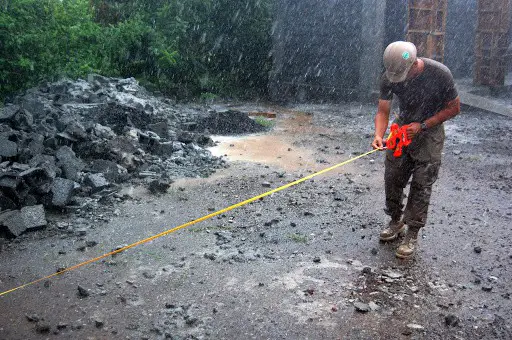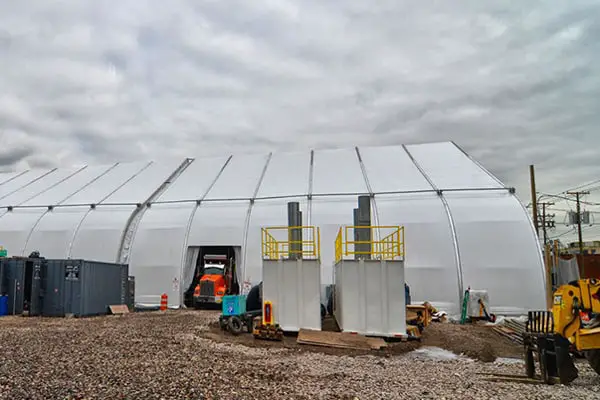It’s not at all an unknown fact that you cannot do cement work without water.
Water is needed in the mixing the cement and binding them together to form concrete floors or walls of buildings.
But the problem arises when you are to construct roadways in the rain with cement. Though primarily cement is required in the mixing of the stuffs together, yet once the road is being constructed, the contact of water with it can make things worse.
And when water interferes with cement work in the form of heavy pouring rain, things can go worse than good! Be it in the time of laying the road with cement or just after the completion of the cement work, rain can cause several damages to the concrete like misshaping the top layer, washing away the top layer of the cement, creating crater like holes on the top layers and in worse cases eroding away the entire cement work in case the mixture of the cement is yet not dry.
But after all, rain is inevitable and you do not know when it will pour down on your work to create the massive damage to work and property!
That is why your friend Stephen is here with this to guide you through all ups and downs while working with cement in the rain!
This article will inform you on all the precautionary measures related to concrete work in the rain, what are the things you should avoid and how to act if it rains after just the completion of the concrete work!
So, let’s get started!
How long does concrete need to dry before it rains?
It might take the concrete from 24 hours to 48 hours to dry completely before any pressure can be applied to it. And it might take up to a week’s time to cure.
Curing and drying are two different things. Curing is a chemical process that can take longer and can take place even in the presence of water.
Curing might even take place till 28 days and can continue throughout the lifespan of the concrete. It is actually the time taken by the concrete to become harder and harder day by day.
Precautionary measures to Pour Concrete in the Rain
It is always advisable to avoid any cement work in case of heavy downpour, but if the situation demands so, there are certainly some precautionary measures which you can take to deal with the situation:
1.) Consult the weather forecasting department:
Consult the weather forecasting department for possibility of rain in the area. Forecasting technology and radar maps can indicate the possibilities of rain in 24 hours in a particular area.
If they inform you of any such downpour, it’s better to hold back on your plan for starting with the concrete work for the particular day.
2.) Cover the entire area before starting with the concrete work:
Even if the weather forecasting department does not inform of any possibilities of rain, you never know what plans mother earth has for you! So, it’s always better to prepare for the worse.
Before you start with your cement work, cover the area with a tarp or plastic sheet. This will prevent the rain from pouring directly on the cement and allow you to work even in the rain. Also, do not forget to seal the edges to prevent the seepage of water underneath.
3.) Scope out the location:
Before beginning with the project, you should look for the presence of any gutters or downspouts because rainwater might gush from the downspouts or the ones cascading over the edge of a roof without the presence of a gutter might carve a trench into the concrete floor if your slab is directly beneath the overflow.
4.) Ensure a good drainage system:
If there is no drainage system near the to be constructed concrete, make sure you take the lead and work out a drain connecting it to the main drain of the street.
This will ensure that if rain pours, it will not gather only on your freshly cemented area, but will flow away in the drain.
See also: Are Vibram Soles Good on Concrete?
How to handle rain after pouring cement/concrete?
In case rain pours just after you have finished with your concrete work, here are some tips you can follow:
1.) Cover the freshly cemented area with a plastic sheet.
2.) Work out a draining channel for the rain water to flow into the main drain.
3.) Do not sprinkle dry cement over the wet with rain water cemented area. This will impair the finish of the cemented area.
4.) When the rain stops, let the cemented area dry completely and then again go for another top layer of final finish and polish.
What damages can rain cause to concrete?
Rain cause from pretty small to large havoc to concrete in the following ways:
→ It can cause dusting of the top layer which will look like an unfinished floor.
→ It can cause surface scaling in which the top layer is completely eroded away.
→ It can cause craze cracking or holes on the surface of the concrete.
→ In case of colored concrete, rain can wash away the color of the concrete floor completely.
→ In case of over saturation of the rain water, it can cause ponding and thus damage the entire concrete work.
→ Rain can cause the sealer to bubble and blisters.
How to repair rain-damaged concrete?
In case rain water has completely damaged your cemented floor, here are some quick fixes to your problem:
-
-
- Quickly remove the top weak layer of the cement by grinding.
- Start resurfacing the concrete with an overlay.
- Apply sealants after the cement has completely dried. This will prevent further damage caused by rain.
-
See also: Best Shoes for Walking on Concrete
Will rain hurt freshly poured concrete?
Yes, rain will definitely hurt the topmost finished layer of the freshly poured concrete by damaging its appearance.
Not only will rain brush away the top layer of the fresh concrete, but if the intensity of rain is heavy, it can even enter the sub layers of the concrete, thus weakening the strength of the concrete mixture and increasing its chances of developing scaling or eroding the entire concrete in some time.
Once the damage has been done by rain to the freshly poured concrete, it is very difficult to alter the damages and the road will be prone to breakage very soon and quite easily.
How long after it rains can you pour concrete?
You should never pour concrete on wet grounds the reason being it will lead to decrease in the strength of the concrete and also make the concrete prone to cracking.
So, you must wait for the ground to be completely dry before poring the concrete. That will entirely depend on the hours of the sunshine after the rain.
If the sunshine is good and strong enough, the ground will dry in a day and if the ground is logged with water, it will demand a week or two’s sunshine to dry completely.
Waiting for the ground to dry completely after rain is very essential because concrete will react with the moisture present in the ground.
Excess of water in the ground will make the cement-water ratio in the concrete mixture to alter and thus the concrete will take longer to dry or will not form the cement crystals to its required strength and density. Also, excess water will make the concrete to crack prematurely and develop scaling.
Well, there are ways by which you can make the wet ground work for pouring the concrete like:
-
-
- Like sprinkling a little sand on the wet ground can help the ground soak up the moisture and dry faster
- If the ground is a bit wet, you can mix less amount of water in the cement-water mixture so that the water that is already present in the ground balances it
-
See also: What Kind of Gloves for Concrete Work?
It’s time to bid Adieu!
Rain water can soften the concrete which in turn can decrease the abrasion resistance power and the strength of the concrete ultimately leading to cracks in the concrete.
The key to prevent this to take the above mentioned precautionary measures and the proper timing!
In case rain pours in between your concrete work, without you taking any precautionary measures, it is advisable to wait until the rain stops and restart from the very first step. After all, a small damage is better to compensated than a larger loss of time, effort and money!
That’s all for today!
Stay tuned to our next upcoming articles!
Till then take care, work safely and…
Have a great day ahead!








